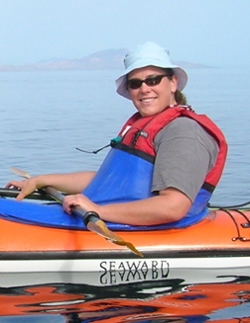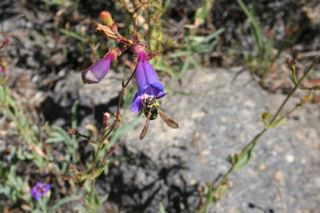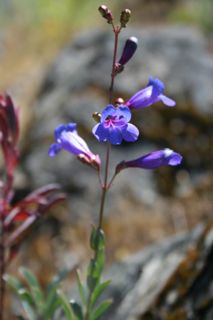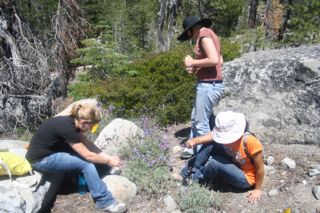
Contact Information
Name: Shannon L. Datwyler
Title: Professor and Chair
Office Location: Sequoia 202
Email: datwyler@csus.edu
Office Phone: (916) 278-6535
Mailing Address: Department of Biological Sciences 6000 J Street Sacramento, CA 95819-6077
Office Hours: Please call or email for an appointment.
Where to find me : Sequoia Hall Room 202
Courses that I have taught
- BIO 001: Biodiversity, Evolution and Ecology (taught every semester)
- BIO 112: Plant Taxonomy (every spring)
- BIO 113: Evolution and Speciation in Flowering Plants (even falls)
- BIO 178: Molecular Ecology (every fall)
- BIO 188: Evolution (every semester)
Publications
Lawrence, T. J. and S. L. Datwyler. 2016. Testing the hypothesis of allopolyploidy in the origin of Penstemon azureus (Plantaginaceae). Frontiers in Ecology and Evolution doi: 10.3389/fevo.2016.00060.
Eckert, A. J., H. Shahi*, S. Datwyler, and D. B. Neale. 2012. Spatially variable natural selection and the divergence between parapatric subspecies of lodgepole pine (Pinus contorta, Pinaceae). American Journal of Botany 99(8): 1323-1334.
Larkey, D. J.*, S. L. Datwyler and W. C. Lancaster. 2012. Vertebral fusion in bats: phylogenetic patterns and functional relationships. In G. F. Gunnell & N. B. Simmons. Evolutionary history of bats: fossils, molecules and morphology, New York: Cambridge University Press.
Fishbein, M., S. Kephart, M. Wilder, K. M. Halpin and S. L. Datwyler. 2010. Phylogeny of Camassia (Agavaceae) inferred from plastid rpl16 intron and trnD-trnY-trnE-trnT intergenic spacer DNA Sequences: implications for species delimitation. Systematic Botany 35(1): 77-85.
Wolfe, A. D., C. P. Randle, S. L. Datwyler, J. J. Morawetz, N. Arguedas and J. Diaz. 2006. Phylogeny, taxonomic affinities, and biogeography of Penstemon (Plantaginaceae) based on ITS and cpDNA sequence data. American Journal of Botany. 93 (11): 1699-1713.
Datwyler, S. L. and G. D. Weiblen. 2006. Genetic variation in hemp and marijuana (Cannabis sativa L.) indicated by amplified fragment length polymorphisms. Journal of Forensic Science 51 (2): 371-375.
Zerega, N. J. C., W. L. Clement, S. L. Datwyler, and G. D. Weiblen. 2005. Biogeography and divergence times
in the mulberry family based on chloroplast and nuclear DNA sequences. Molecular Phylogenetics and Evolution, 37: 402-416.
Datwyler, S. L. and G. D. Weiblen. 2004. On the origin of the fig: phylogenetic relationships of Moraceae from ndhF sequences. American Journal of Botany 91(5): 767-777.
Datwyler, S. L. and A. D. Wolfe. 2004. Phylogenetic and biogeographic relationships of Penstemon subg. Dasanthera. Systematic Botany 29(1): 165-176.
Wolfe, A. D., S. L. Datwyler and C. P. Randle. 2002. Evolutionary biogeographic relationships among tribe Cheloneae (Scrophulariaceae). Systematic Botany 27(1): 138-148.
*Student Author
Presentations at Professional Meetings
Datwyler, S. L. 2012. Testing the hypothesis of the hybrid origin of Penstemon newberryi var. berryi (Plantaginaceae). Botany 2012 Annual Meeting, Columbus, OH; Oral Presentation.
Lawrence, T.* and S. Datwyler. 2012. Testing the hypothesis of allopolyploidy in the origin of Penstemon azureus (Plantaginaceae). Botany 2012 Annual Meeting, Columbus, OH; Student Oral Presentation.
Visger, C.* and S. Datwyler. 2012. A Cytogeographical survey of California Penstemon section Saccanthera subsection heterophylli. Botany 2012 Annual Meeting, Columbus, OH; Student Oral Presentation.
Lawrence, T., S.* Datwyler and E. Padilla-Valdivia*. 2012. Testing the hypothesis of allopolyploidy in the origin of Penstemon azureus (Plantaginaceae). California State University Biotechnology Research Symposium; Student Poster Presentation.
Visger, C.* and S. Datwyler. 2012. A Cytogeographical survey of California Penstemon section Saccanthera subsection heterophylli. California State University Biotechnology Research Symposium; Student Poster Presentation.
Padilla-Valdivia, E.* and S. Datwyler. 2011. Using DNA sequence data to examine evolutionary relationships in Penstemon. California State University, Sacramento Undergraduate Research Reception; Student Poster Presentation.
Visger, C.* and S. Datwyler. 2011. A Cytogeographical survey of California Penstemon section Saccanthera subsection heterophylli. California State University, Sacramento Undergraduate Research Reception; Student Poster Presentation.
Rhodes, Terrel, Terry Underwood, Janet Hecsh , Shannon Datwyler and Jeffrey Brodd. 2010. The VALUE Rubrics –Touchstones for the Scholarship of Teaching and Learning. Oral presentation at the WASC Academic Resource Conference in Long Beach, CA.
Simpson, L. T.* and S. L. Datwyler. 2007. Testing the hypothesis of Hybrid Speciation in Penstemon newberryi var. berryi. Poster presentation at Botany 2007 Annual Meetings, Chicago, IL.
*Student Author
Research Projects/Interests
The overall goal of my research is to understand the ecological and genetic factors that promote speciation. My current research program has three primary focal areas: (1) understanding biogeographic and phylogeographic patterns among closely-related species complexes in Penstemon, (2) coevolution of Penstemon and specialist pollinators, and (3) the importance of polyploidy in diversification. To address these questions, I use both field and laboratory-based techniques. In the field, my work involves pollinator observations and manipulative field experiments. In the laboratory, I use DNA sequence data to develop phylogenetic hypotheses, and microsatellite and AFLP markers to understand finer scale population structure.
I am currently working on several projects within Penstemon subsection Heterophylli. This subsection includes 12 species in western North America that vary in ploidy level from diploid to tetraploid, hexaploid and octoploid. Furthermore, species in this complex are visited by specialized pollen wasps, Pseudomasaris vespoides. To address biogeographic and phylogeographic patterns in the genus, we are using DNA sequence data from both the nuclear and chloroplast genome. Prelimimary results suggest that the widespread hexaploid species, Penstemon azureus, has resulted from an allopolyploidy event which likely involved P. heterophyllus, a species with both diploid and tetraploid cytotypes. We have also documented the geographic range of diploid and tetraploid cytotypes in P. heterophyllus and found that the tetraploid populations are limited to the southern Klamath region in California. We are currently addressing the role of Pseudomasaris pollination in the evoution of Penstemon subsect. Heterophylli.
Professional Associations
Interesting Links

Penstemon heterophyllus 2X cytotype in flower

Pseudomasaris vespoides visiting Penstemon neotericus (octoploid)

Penstemon heterophyllus 4X cytotype

Students collecting samples of Penstemon heterophyllus

Students taking measurements on Penstemon azureus (hexaploid)